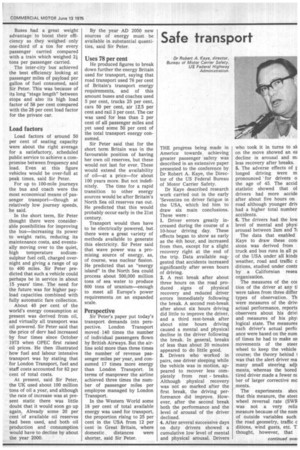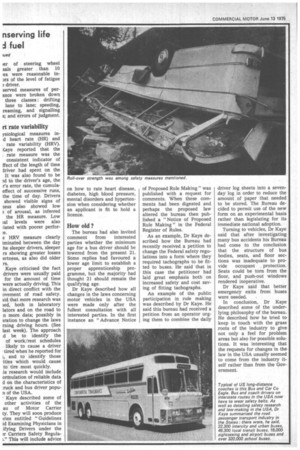THE progress being made in Americatowards achieving greater passenger safety
Page 37

Page 38

If you've noticed an error in this article please click here to report it so we can fix it.
was described in an extensive paper presented to the conference by Dr Robert A. Kaye, the Director of the US Federal Bureau of Motor Carrier Safety.
Dr Kaye described research work carried out in the early 'Seventies on driver fatigue in the USA, which led him to draw six main conclusions. These were : 1. Driver errors greatly increased during the course of a 10-hour driving day. These effects began to show as early as the 4th hour, and increased from then, except for a slight recovery right at the end of the trip. Data available suggested that accidents increased significantly after seven hours of driving.
2. A rest break after about three hours on the road pro duced . signs of physical recovery and reduced driver errors immediately following the break. A second rest-break. after about six hours driving did little to improve the driver, and a third rest-break after about nine hours driving caused a mental and physical decline in the driver following the break. In general, breaks of less than about 20 minutes appeared to do little good.
3. Drivers who worked in pairs, one driver sleeping while the vehicle was in motion, appeared to recover less completely from rest breaks. Although physical recovery was not so marked after the first break, the driving performance did improve. However, after the second break both the performance and the level of arousal of the driver declined.
4. After several successive days on duty drivers showed a cumulative low level of mental and physical arousal. Drivers who took it in turns to sli on the move showed an ea decline in arousal and m; less recovery after breaks. 5. The adverse effects of r longed driving were m pronounced 'for drivers o the age of 45. The accid statistic showed that ol drivers had more accide after about five hours on road although younger driv • had a higher total number accidents.
6. The drivers had the low level of mental and physi arousal between 2am and "h The data that enabled Kaye to draw these con< sions was derived from truck and bus runs in all ptof the USA under all kinds weather, road and traffic c ditions, studied under contr by a Californian resea organisation.
The measures of the cor tion of the driver at any ti were taken from three differ types of observation. Th were measures of the drivi actual performance, reports observers about his drivi and measures of his phy logical state. The measures each driver's actual perfo: ance were based on the num of times he had to make sn movements of the steer wheel to keep the vehicle course; the theory behind I was that the alert driver ma many small steering adji ments, whereas the bored tired driver made a fewer m ber of larger corrective mc ments.
The experiments shos that this measure, the steer wheel reversal rate (SWP was not a very relis measure because of the num of outside variables such the road geometry, traffic c ditions, wind gusts, etc. T: thought, however, that Per of steering wheel sals greater than 10 es were reasonable inors of the level of fatigue ! driver.
served measures of perance were broken down three classes : drifting lane to lane; speeding, reaming, and signalling s; and errors of judgment.
rt rate variability
ysiological measures in d heart rate (HR) and rate variability (HRV). Kaye reported that the rate measure was the consistent indicator of ffect of the length of time lriver had spent on the It was also found to be ?.d to the driver's age, the r's error rate, the cumulaeffect of successive runs, the time of day. Drivers showed visible signs of aess also showed low 3 of arousal, as inferred the HR measure. Low ;al levels were also :iated with poorer perfor:e.
e HRV measure clearly iminated between the day he sleeper drivers, sleeper rs showing greater losses ertness, as also did older rs.
Kaye criticised the fact drivers were usually paid for the amount of time were actually driving. This in direct conflict with the ovement of road safety. lid that more research was led, both in laboratory lators and on the road to n more data; possibly in aration to change the laws rning driving hours. (See last week). The approach d be to identify the of work/rest schedules likely to cause a driver tired when he reported for and to identify those • ities which would cause to tire most quickly.
is research would include ormulation of reliable data d on the characteristics of ;ruck and bus driver popun of the USA.
: Kaye described some of other activities of the au of Motor Carrier ty. They will soon produce !ries entitled "Guidelines id Examining Physicians in ifying Drivers under the r Carriers Safety RegulaL" This will include advice on how to rate heart disease, diabetes, high blood pressure, mental disorders and hypertension when considering whether an applicant is fit to hold a licence.
How old ?
The bureau had also invited comment from interested parties whether the minimum age for a bus driver should be lowered from the present 21. Some replies had favoured a lower age limit to establish a proper apprenticeship programme, but the majority had thought 21 should remain the qualifying age.
Dr Kaye described how all changes in the laws concerning motor vehicles in the USA were made only after the fullest consultation with all interested parties. In the first instance an "Advance Notice of Proposed Rule Making" was published with a request for comments. When these comments had been digested and perhaps the proposed law altered the bureau then published a "Notice of Proposed Rule Making" in the Federal Register of Rules.
As an example, Dr Kaye described how the Bureau had recently received a petition to change the Federal safety regulations into a form where they required tachographs to be fitted to buses. He said that in this case the petitioner had laid great emphasis both on increased safety and cost saving of fitting tachographs.
An example of the public participation in rule making was described by Dr Kaye. He said this bureau had received a petition from an operator urging them to combine the daily driver log sheets into a sevenday log in order to reduce the amount of paper that needed to be stored. The Bureau decided to permit use of the new form on an experimental basis rather than legislating for its immediate national adoption.
Turning to vehicles, Dr Kaye said that after investigating many bus accidents his Bureau had come to the conclusion that the structure of bus bodies, seats, and floor sections was inadequate to provide occupant protection. Seats could be torn from the floor, and push-out windows rendered inoperative.
Dr Kaye said that better emergency exits from buses were needed.
In conclusion, Dr Kaye described some of the underlying philosophy of the bureau. He described how he tried to keep in touch with the grass roots of the industry to give not only a feel for problem areas but also for possible solutions. It was interesting that the requests for changes in the law in the USA usually seemed to come from the industry itself rather than from the Government.




















































































